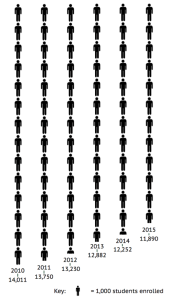Enrollment drop expected for fourth year
Rebecca Jordan
News Editor
How will the predicted three percent decline in enrollment for the spring 2016 semester affect you?
Fall 2015 closed with an enrollment number of 11,888 students. Though spring 2016 numbers have not officially been reported because students are still being enrolled, the college has been planning ahead for the decline so it did not catch the college unaware. According to Dennis Kennedy, director of communications and marketing, the college puts forth an enrollment projection two or three years in advance in order to be able to plan ahead.
This decline is, in part, due to the amount of students graduating high school, which has experienced a 2.7 percent decline from numbers this past year. According to Kennedy, this is the fifth or sixth year in a row less students have come out of high school because parents are not having as many kids. When less students graduate high school, there is a smaller recruitment pool for colleges to target.
Another cause for enrollment decline is tied to the economy. During the Great Recession the United States experienced from 2008 to around 2012, institutions throughout the nation saw a surge in enrollment. Now that the economy is recovering, less students feel the need to go to college.
“Recessions are marked by high unemployment – people are out of work, less jobs are being created, and they are harder to get. There’s no economic growth, so there’s no new jobs,” Kennedy explained. “When there’s high unemployment, people come back to college to get trained to give them an advantage in the job market.”
When enrollment drops slightly, there is a corresponding loss in tuition revenue. Out of the college’s total budget of around $110 million for this academic year, about 38% of that revenue comes from student tuition. 20% of the remaining budget money comes from county governments, 21.5% is state aid, and 19% comes from other places.
Kennedy says that while tuition and fees are one part of the college’s operating budget, significant funds do come in from other sources. “[Enrollment] is partially tied to the tuition revenue the college receives as a whole, which could have implications on the end student tuition, but that has to be balanced with a look at every other funding source the college has. It’s a multi-faceted issue,” Kennedy said.
Tuition did increase in the 2015-16 academic year. Governor Andrew Cuomo’s new proposed state budget for this upcoming year did not include any additional funding for community colleges, and costs are rising every year. “The last thing the college will do in order to balance its budget is raise tuition or fees because it’s our mission to make higher education affordable,” said Kennedy.
Aside from tuition and fee costs, the decrease in enrollment may not dramatically affect the daily lives of students. Because there are less students, there is a corresponding decrease in the revenue earned from services that students pay for in addition to tuition, such as the bookstore and cafeteria.
Some effects of lower enrollment can be considered positive. The college does not cut staff in times of modest decline, so if there are less students needing the attention of the same amount of professors and staff, the services received by student should theoretically be enhanced. In addition, parking should improve, there will be more space in labs and study area, and it will be easier to make appointments with advisors.
Kennedy believes that these effects, however, will be minor. “When there’s 200 less students, do you really feel it in an institution that has almost 12,000 students?” he asked. “You can look at tuition as one angle, but I don’t think that, on a day-to-day level, the service that a student receives from this college is any different.”

